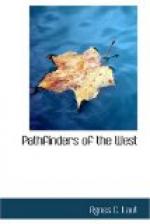Near Norton sat another famous Indian, Matonabbee, the son of a slave woman at the fort, who had grown up to become a great ambassador to the native tribes for the English traders. Measuring more than six feet, straight as a lance, supple as a wrestler, thin, wiry, alert, restless with the instinct of the wild creatures, Matonabbee was now in the prime of his manhood, chief of the Chipewyans at the fort, and master of life and death to all in his tribe. It was Matonabbee whom the English traders sent up the Saskatchewan to invite the tribes of the Athabasca down to the bay. The Athabascans listened to the message of peace with a treacherous smile. At midnight assassins stole to his tent, overpowered his slave, and dragged the captive out. Leaping to his feet, Matonabbee shouted defiance, hurled his assailants aside like so many straws, pursued the raiders to their tents, single-handed released his slave, and marched out unscathed. That was the way Matonabbee had won the Athabascans for the Hudson’s Bay Company.
Officers of the garrison, bluff sea-captains, spinning yarns of iceberg and floe, soldiers and traders, made up the rest of the company. Among the white men was one eager face,—that of Samuel Hearne, who was to explore the interior and now scanned the birch-bark drawings to learn the way to the “Far-off-Metal River.”
[Illustration: Samuel Hearne.]
By November 6 all was in readiness for the departure of the explorer. Two Indian guides, who knew the way to the North, were assigned to Hearne; two European servants went with him to look after the provisions; and two Indian hunters joined the company. In the gray mist of Northern dawn, with the stars still pricking through the frosty air, seven salutes of cannon awakened the echoes of the frozen sea. The gates of the fort flung open, creaking with the frost rust, and Hearne came out, followed by his little company, the dog bells of the long toboggan sleighs setting up a merry jingling as the huskies broke from a trot to a gallop over the snow-fields for the North. Heading west-northwest, the band travelled swiftly with all the enthusiasm of untested courage. North winds cut their faces like whip-lashes. The first night out there was not enough snow to make a wind-break of the drifts; so the sleighs were piled on edge to windward, dogs and men lying heterogeneously in their shelter. When morning came, one of the Indian guides had deserted. The way became barer.




